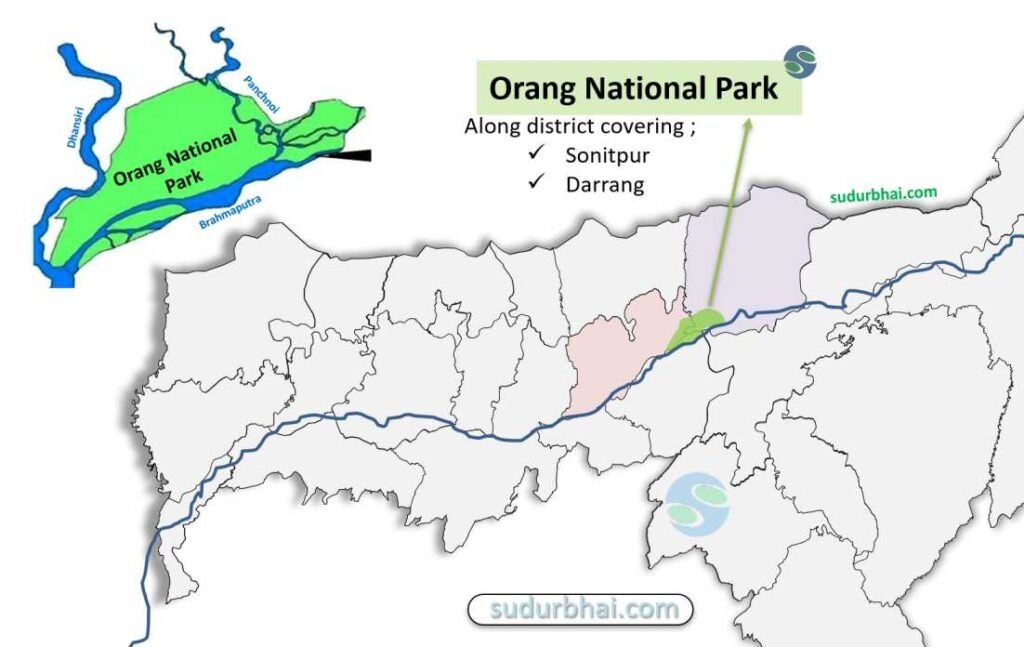Orang National Park

1. Location and Area of Orang National Park
- Geographical Location: Northern Assam along the northern banks of the Brahmaputra River.
District Covered: Darrang and Sonitpur.
Total Area: 299.14 sq. km
Landscape Features:
Located in the alluvial floodplains of the Brahmaputra.
Consists of swamps, wetlands, riverine grasslands, semi-evergreen forests, and dry savannah woodlands.

2. Year of Establishment of Orang National Park
- Declared as a Game Reserve: 1915 (during British rule).
Declared as a Wildlife Sanctuary: 1985.
Declared as a National Park: 1999.
Declared as a Tiger Reserve: 2016 (49th Tiger Reserve of India).
3. Biodiversity of Orang National Park
A. Flora of Orang National Park
- Vegetation Types:
Tropical Semi-Evergreen Forests.
Moist Deciduous Forests.
Wetland Vegetation and Riverine Grasslands.
Dominant Plant Species:
Trees: Sal, Simul, Teak, Arjun, Ajar, Outenga (Elephant Apple).
Grasses: Tall elephant grass, Barenga Grass, and aquatic plants.
Swamp & Wetland Vegetation: Reeds, cane, and aquatic species like water hyacinth.
B. Fauna of Orang National Park
- Mammals
Key Species:
Greater One-Horned Rhinoceros (Main attraction, with around 125+ individuals).
Royal Bengal Tiger (High tiger density relative to area).
Asiatic Elephant (Migrates between Orang and Kaziranga).
Pygmy Hog (Critically Endangered, unique to Assam).
Wild Boar, Hog Deer, Barking Deer, Sambar Deer.
Leopards and Civets.
Avifauna (Birdlife – Important Bird Area by BirdLife International)
Over 220 species of birds recorded.
Key Bird Species:
Spot-billed Pelican, Great White Pelican, Indian Skimmer.
Pallas’s Fish Eagle, Black-necked Stork, Bengal Florican (Critically Endangered).
Kingfishers, Egrets, Herons, and Migratory Waterfowl.
Reptiles & Amphibians
Gharial, Indian Python, King Cobra, Monitor Lizard.
Turtles and Freshwater Dolphins in Brahmaputra River.
- Mammals
4. Major Rivers and Terrain of Orang National Park
A. Major Rivers of Orang National Park
Brahmaputra River (southern boundary)
- Dhansiri river (Western boundary)
- Pachnoi River ( Eastern Area Of Park)
B. Terrain & Climate of Orang National Park
Landscape:
Floodplain ecosystem with grasslands, swamps, and water bodies.
Seasonal flood dynamics influence habitat and wildlife movement.
Climate:
Tropical Monsoon Climate with hot summers and mild winters.
Annual Rainfall: 2500-3500 mm, leading to seasonal floods.
5. Conservation Challenges and Successes in Orang National Park
A. Conservation Challenges
Poaching of Rhinoceros and Tigers
Orang has faced severe poaching threats, especially for rhino horns.
The park was once called “Mini Kaziranga” but suffered due to poaching in the 1990s.
Organized poaching networks linked to international illegal wildlife trade.
Human-Wildlife Conflict
Elephants raid crops, leading to conflicts with villagers.
Tiger attacks on livestock create hostility among locals.
Encroachment and Habitat Degradation
Illegal settlements around the park increase pressure on resources.
Deforestation and overgrazing by domestic cattle threaten the grasslands.
Flooding and Erosion by Brahmaputra
Annual floods submerge large portions of the park.
Soil erosion reduces habitat availability for key species.
B. Conservation Successes
Successful Rhino Conservation Efforts
Strict anti-poaching measures led to a rise in rhino numbers.
Population increased from 68 in 2006 to 125+ in recent years.
Decline in Poaching Cases
Deployment of armed forest guards and use of drones for monitoring.
Strong coordination with local communities and law enforcement.
Tiger Density Increased
Orang has one of the highest tiger densities in India (about 5-6 tigers per 100 sq. km).
Part of the Kaziranga-Orang-Burachapori Tiger Corridor.
Recognition as a Tiger Reserve (2016)
Led to increased funding, better surveillance, and habitat management.
Community Participation and Eco-Tourism
Villagers engaged in conservation programs.
Promotion of eco-tourism and nature safaris to reduce dependence on forest resources.
6. Eco-Tourism and Adventure Activities in Orang National Park
- Jeep Safari & Rhino Spotting: Tourists can spot rhinos, elephants, and tigers in open grasslands.
Boat Safari on Brahmaputra River: For birdwatching and spotting freshwater dolphins.
Birdwatching Tours: Especially popular for Bengal Florican, Kingfishers, and Pelicans.
Nature Walks and Wildlife Photography.
